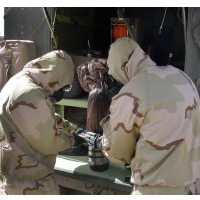U.S. Kept Quiet about ’80s-Era Chemical Weapons it Helped Provide to Iraq ... Especially When American Soldiers Were Later Hurt by Them
 Explosives team seals sarin shell that wounded U.S. soldiers in Iraq, 2004 (photo: Christopher Jewett, U.S. Navy)
Explosives team seals sarin shell that wounded U.S. soldiers in Iraq, 2004 (photo: Christopher Jewett, U.S. Navy)
It turns out that President George W. Bush was right—there were weapons of mass destruction in Iraq. The part he left out, though, was that the weapons had been there since the 1980s and the United States had a hand in their manufacture.
According to reporting by C.J. Chivers of The New York Times, at least 17 members of the U.S. armed forces were wounded by chemical weapons—including mustard gas and the nerve agent sarin—that they found during the Iraq war from 2004 to 2011. The U.S. government clamped a lid of secrecy on the discoveries, even denying proper treatment to some of the service members who were wounded. Military officers and others who knew the truth were ordered to say nothing or lie.
“'Nothing of significance’ is what I was ordered to say,” former Army major Jarrod Lampier, who witnessed the discovery of more than 2,400 nerve-agent rockets, told the Times.
“They told us that this was something that was going to be kept confidential for a long time,” confirmed former corporal Jace M. Klibenski.
“They put a gag order on all of us — the security detail, us, the clinic, everyone,” James F. Burns, who as a sergeant in Iraq suffered severe symptoms from handling shells containing sarin, told the newspaper. “We were briefed to tell family members that we were exposed to ‘industrial chemicals,’ because our case was classified top secret.” (The incident was cited in the 2004 Iraq Survey Group report that concluded Iraq had no chemical weapons program in a decade. It was the only time information about troop exposure to chemical weapons got out. “There may be more out there,” warned former U.N. official Charles A. Duelfer, who, as a CIA advisor, presented the report.)
Part of the reason for the secrecy is that the discoveries didn’t fit the Bush Administration narrative of a current chemical weapons program run by Iraqi leader Saddam Hussein. The munitions had been made for use in Iraq’s war against Iran and none were made after 1991.
Most damning was the fact that the chemical weapons had been designed—and some of its key elements supplied—by the United States. This was accomplished under the Ronald Reagan administration, which sought to arm Saddam Hussein against Iran. Additional contributions to these munitions came from Western Europe.
Discarded M110 shells that were discovered still contained mustard gas, which burns the eyes, skin and respiratory system. Those shells had been designed in the United States, which were sent along with the technology to other countries for manufacture. Italy and Spain were among those countries, which sold the end product to Saddam.
Two U.S. companies—Cardinal Stabilizer of Charleston, South Carolina, and Alcolac International of Baltimore—provided the dictator with the chemical thiodiglycol, or TDG, necessary for the manufacture of the mustard gas. In shipping out the TDG, the companies hid the fact that Iraq was the chemical’s ultimate destination.
Due to the secrecy imposed by the U.S. government on the existence of these weapons, none of the troops wounded by the munitions, nor any military doctors, were told that chemical agents were the cause. Consequently, none of the soldiers were given proper treatment; in many cases they were not hospitalized and commanders’ requests that they be evacuated to the U.S. were denied. Instead they got cream to apply on the blisters caused by the gas. Some were even put back into the field despite continuing symptoms from their exposure to the chemical agent. They were sometimes even denied Purple Hearts ordinarily awarded to those wounded in battle—higher-ups said their wounds hadn’t come as a result of enemy action.
“That stuff didn’t exist … [those] wounds never happened,” former Army sergeant Jarrod L. Taylor sarcastically told the Times. Two soldiers in Taylor’s infantry unit were burned by the chemical agents, the subsequent destruction of which he personally witnessed. “I love it when I hear, ‘Oh there weren’t any chemical weapons in Iraq.’ There were plenty.”
Although it has been verified that 17 U.S. soldiers, as well as seven Iraqi police officers, were exposed to the nerve agents after 2003, U.S. officials say that the actual number of victims—which is classified—is higher.
About 5,000 chemical devices were found in Iraq, according to U.S. intelligence documents and interviews with U.S. and Iraqi officials. Many of the weapons were discovered in and around the Muthanna State Establishment, which was Saddam’s main chemical weapons plant in the 1980s. Iraq had a plan in 2012 to entomb the site in concrete, burying the chemicals forever, but didn’t get around to completing the work. Earlier this year, forces from the Islamic State took over the area containing Muthanna.
-Steve Straehley, Danny Biederman
To Learn More:
The Secret Casualties of Iraq’s Abandoned Chemical Weapons (by C.J. Chivers, New York Times)
Number of Americans Wounded in Iraq is Obscured by Fog of War…and Peace (by Noel Brinkerhoff, AllGov)
Almost One-Third of U.S. Soldiers Killed in Iraq Aged 21 or Younger (AllGov)
- Top Stories
- Unusual News
- Where is the Money Going?
- Controversies
- U.S. and the World
- Appointments and Resignations
- Latest News
- Musk and Trump Fire Members of Congress
- Trump Calls for Violent Street Demonstrations Against Himself
- Trump Changes Name of Republican Party
- The 2024 Election By the Numbers
- Bashar al-Assad—The Fall of a Rabid AntiSemite






Comments